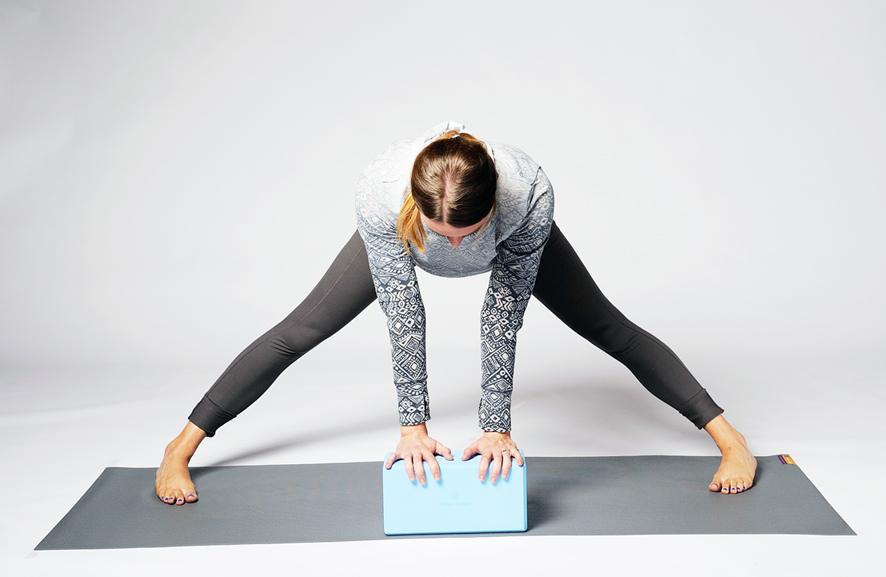This entry was posted on Could 6, 2025 by Charlotte Bell.

Prasarita Padottanasana (Extensive-Legged Standing Ahead Bend Pose) is one in every of yoga’s extra stress-free standing poses. Its symmetrical form retains your pelvis, sacroiliac joint and backbone impartial, whereas the energetic rooting of your toes and legs permits your higher physique to be smooth and receptive. These advantages can be found to just about everybody—with just a little assist from a Yoga Block.
Why Apply Prasarita Padottanasana?
Working towards Prasarita Padottanasana confers many advantages. It strengthens and stretches the inside legs, hamstrings and backbone; tones the belly organs; and calms the mind. It’s mentioned to alleviate some complications and scale back fatigue.
Prasarita could be contraindicated for folks with tight hamstrings. When your hamstrings are taut, your pelvis can’t tilt ahead together with the backbone. This could put strain on the discs within the decrease again, which may result in disc issues. Additionally, curling the torso ahead so as to attain the ground contracts your belly muscle tissues, limiting free respiratory.
Utilizing a Yoga Block in Prasarita Padottanasana will help folks of all ranges of flexibility follow safely and comfortably. Anybody can profit from utilizing a Yoga Block on this pose. My hips and hamstrings are fairly versatile, however I nonetheless take pleasure in utilizing a block on this pose for the sensation of continuity it creates in my torso. A number of of my most flexible college students take pleasure in utilizing a block as properly.
Yoga Blocks can be found in cork, 3-inch or 4-inch foam, marbled foam, recycled foam or wooden. Hugger Mugger’s Massive Block is further giant for further stability and luxury.
The way to Apply Prasarita Padottanasana with a Yoga Block
- Start by standing on a nonskid Yoga Mat along with your toes hips-width aside.
- Soar or step your toes out to a large stance, a few leg-length aside.
- Plant your toes into the bottom, feeling the footprint you’re making in your mat. Are the inside and outer heels and balls of your toes planted evenly? If not, likelihood is you might really feel the load sagging into your inside toes. Permit the muscle tissues and pores and skin of your outer legs to stream down alongside your bones out of your hips to your outer toes that will help you root the toes extra evenly.
- Place your fingers in your hips. Bending out of your hip joints, let your torso come ahead so far as it can go with out dropping contact with deep respiratory.
- Place your fingers on the ground and take a number of breaths. Now place your fingers on a Yoga Block and examine in to see how that modifications your respiratory. A Massive Blue Block or two 4-inch Yoga Blocks work greatest, however you may also use a single 4-inch Yoga Block. Every block has three dimensions: tall, medium and flat. Strive every one to see which feels greatest.
- Keep for five or 10 deep breaths.
- To come back up, place your fingers in your hips and elevate again as much as an upright place. Place your palms collectively in entrance of your coronary heart, bend your knees barely and permit the load of your pelvis to launch into your legs. Loosen up your stomach and breathe deeply, resting.
About Charlotte Bell
Charlotte Bell found yoga in 1982 and commenced instructing in 1986. Charlotte is the creator of Conscious Yoga, Conscious Life: A Information for On a regular basis Apply and Yoga for Meditators, each printed by Rodmell Press. Her third e book is titled Hip-Wholesome Asana: The Yoga Practitioner’s Information to Defending the Hips and Avoiding SI Joint Ache (Shambhala Publications). She writes a month-to-month column for CATALYST Journal and serves as editor for Yoga U On-line. Charlotte is a founding board member for GreenTREE Yoga, a non-profit that brings yoga to underserved populations. A lifelong musician, Charlotte performs oboe and English horn within the Salt Lake Symphony and folks sextet Crimson Rock Rondo, whose DVD received two Emmy awards.

